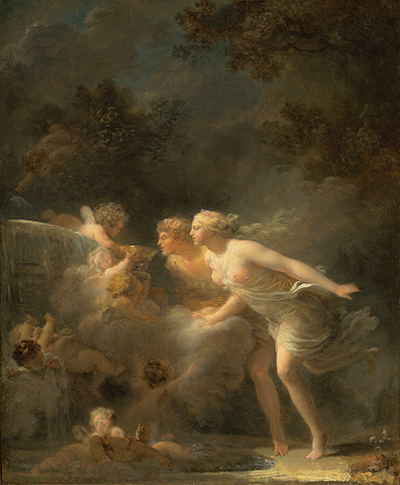Jean-Honore Fragonard produced two near-identical paintings in 1785, both titled The Fountain of Love.
The artist made use of gardens within his paintings frequently, appreciating the combination of figurative art within nature. These domestic spots also offered a greater level of control over composition than if he had worked within parks or forests. The Fountain of Love darks the background to allow the full focus to be placed upon the figures in the foreground who lean over to the fountain. This darker contrast was unusual for the artist, but leaves behind a dramatic finish which may even remind some of the bold use of lighting by artists outside of the Rococo art movement, and even the overall period. See, for example, the likes of Rembrandt's Return of the Prodigal Son and Night Watch and Caravaggio's Supper at Emmaus.
There is an element of fantasy to this painting, where a looseness to the brushwork leaves behind a blurred, almost dream-like appearance to the major parts of the composition. Fragonard used garden sculpture and furniture in many of his paintings, but they don't normally take quite the level of prominence as found here, where the fountain serves as the focal point and also features in the title of the piece. One reason would be that there is a symbolic role played by fountains within most paintings, as they go much further than just an aesthetic role. Purity and health can be served by its inclusion, similar to how others made use of the Tree of Life.
The two different versions can be found in the Wallace Collection in London, UK and also The J. Paul Getty Museum in Los Angeles, US. The latter was larger, but only by a difference of a few centimetres. There was a recent National Gallery research piece that compared the two, but in truth most typical art followers would treat them essentially as identical artworks. Artist Fragonard himself had been employed by Francois Boucher to produce replicas of the master's finest artworks as part of his general tasks within the studio. Therefore, he was not unused to there being more than one version of a particularly painting, even from an early age.




